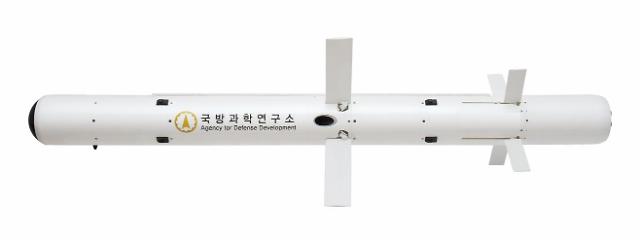S. Korea's homemade air-to-ground missile for helicopters ready for field operation
Lim Chang-won Reporter Posted : 2022-12-19 11:14:14
SEOUL -- South Korea completed the development of its first homemade air-to-ground guided missile system for armed helicopters, called "Cheongeom," after it was judged suitable for combat in a field performance test. The localization of air-to-ground guided missiles was linked to the development of a light-armed helicopter aimed at replacing an aging fleet of light helicopters such as MD500s and AH-1S Cobra.
Cheongeom, also known as TAipers (Tank Snipers), is equipped with an artificial intelligence (AI) algorithm. Through deep learning of target images with more than 800,000 frames, fixed targets can be automatically captured without operator intervention in case of emergency, according to the Defense Acquisition Program Administration (DAPA), a state arms procurement agency.
Comparing it to the U.S. AGM-114 Hellfire air-to-ground missile that can be launched from multiple air, sea, and ground platforms, the agency voiced confidence in the competitiveness, performance and guidance capability of TAipers, saying its accuracy rate, and penetration power are equal to or higher than similar foreign systems.
DAPA said that TAipers reduced operating time while increasing accuracy and the survivability of operators. It can be launched even from non-visible lines by applying wired data links and features fire-and-forget and fire-and-update functions as well as a "double-mode" seeker that utilizes both visible and infrared images to increase day-and-night detection performance.
Fire-and-forget is a type of missile guidance that does not require further external intervention after launch. A fire-and-update missile can designate or re-designate the target through a wired data link, allowing the seeker to automatically track.
TAipers' localization rate is more than 96 percent in terms of cost, DAPA said, suggesting the new homemade missile can lead to the development of various derivatives for ground platforms. The extension of range, the diversification of warheads, the application of wireless data links, and the advancement of AI would be considered.
"With the successful development of Cheongeom with excellent performance, we hope it will be competitive not only for domestic small armed helicopters but also in overseas markets," Brigadier General Lee Jong-hwa, a DAPA official in charge of helicopter business, said in a statement on December 19.
Cheongeom adopted a tandem warhead capable of breaking explosive reactive armor. With a flight range of eight kilometers (4.97 miles), it is guided by wire through an optical cable. If necessary, it is automatically guided to fire and forget. The missile weighing 35kg is 1.7 m in length and 150 mm in diameter.
Cheongeom has been developed by the research center of Hanwha Corporation in a military project led by the Agency for Defense Development (ADD). Korea Aerospace Industries (KAI), the sole aircraft maker in South Korea, won final approval on November 28 to produce light-armed helicopters (LAHs) with an injection of 5.75 trillion won ($4.29 billion) for nine years by 2031.
South Korea became the seventh country in the world to produce attack helicopters. The development of light-armed helicopters was based on H-155, a twin-engine helicopter created by European aircraft maker Airbus. The LAH carrying a 20mm machine gun and four anti-tank missiles or 70mm rocket pods can fly at a maximum speed of 324km per hour.
The LAH project is aimed at developing attack helicopters suitable for a future battlefield environment. KAI has tied up with Israel Aerospace Industries (IAI) on cooperation for manned and unmanned teaming (MUM-T) operations, which are the cooperative employment of unmanned assets with traditional manned platforms.

S. Korea's homemade air-to-ground missile for helicopters ready for field operation | Aju Press
SEOUL --South Korea completed the development of its first homemade air-to-ground guided missile system for armed helicopters, called "Cheongeom," after it was judged suitable for combat in a field performance test. The localization of air-to-ground guided missiles was linked to the development...


